Heterodont bivalves (Subclass Heterodonta) are bivalves with elaborate, folded leaf-like gills used for both respiration and feeding. The shells have a complex hinge with small numbers of different types of teeth. The shell is never nacreous. They are mostly burrowers (though there are exceptions), and usually possess well-developed siphons, comprising an incurrent siphon which water enters with planktonic food particles to be filtered by the gills, and an excurrent siphon which filtered water is expelled.
Here are some of the heterodonts that I have photographed and identified on our shores so far (thanks to Siong Kiat who gave tips on how to identify them!). You may want to take a look at the diagram below if you are not familiar with the names of the parts, so as to better understand the terms used.
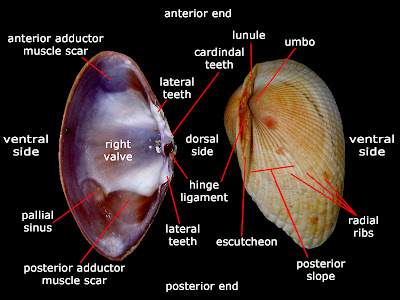
Family Cardiidae
Traditionally, the family Cardiidae consists of only the true cockles, but recent studies shown that the giant clams (previously placed in a family of their own, Tridacnidae) should be part of this family as well. Members of this family typically have strong, compact and completely symmetrical shells which appear heart-shaped when viewed from the anterior end due to the prominent umbones. The shell usually has obvious radial ribs, and on the inside, there are two cardinal teeth in each valve and no pallial sinus. They have short siphons, external ligaments, and most of the motile species have a well-developed, sickle-shaped foot, which allows them to move in short leaps over the substrate. Many species harbour symbiotic algae, which photosynthesize and share the food produced with the host bivalves, in exchange for shelter and nutrients (the metabolic waste of the host). Some species are collected for food or for making shellcraft. Note that the "See Hum" or "blood cockles" used in various local dishes are not true cockles, but arkshells (Family Arcidae) instead.
Here are some of the cockles that I have photographed:

The Pacific Yellow Cockle (Vasticardium flavum) is usually found among seagrass or seaweed. It is usually somewhat yellowish in colour, and often with dark stains.
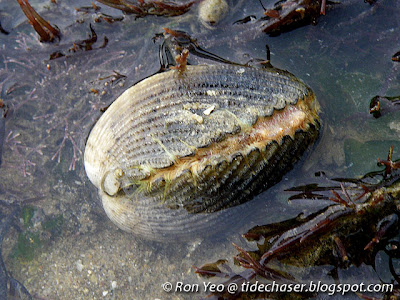
Like other cockles, the shell appears heart-shaped when viewed from the front or back. The radial ribs are marked with scale-like structures running down the length. It gets to about 5cm long.
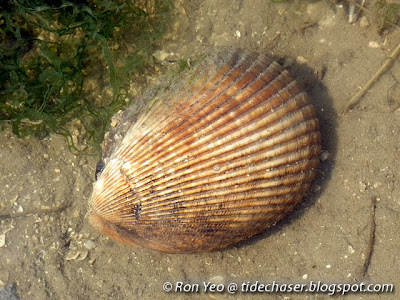
This is possibly a Laevicardium sp., which has more pointed umbones and a more elongated shell. It is usually seen on sandy substrates among seagrass or seaweed.
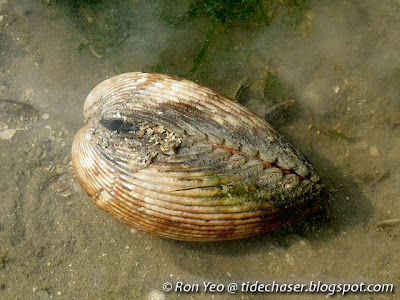
Another view of the same shell, which exhibits the heart-shaped appearance. It is about 5cm long.

The Strawberry Cockle (Fragum unedo) is seen on sandy substrate on reef flats. The shell, which appears somewhat squarish, is marked with red spots.

Here's another view of the shell. Strawberry cockles can grow to about 5cm long.

The Heart Cockle (Corculum cardissa), unlike most other cockles, are compressed anterior-posteriorly (front-back), and appears like a flattened heart, with the opening in the middle of the heart. The shell is rather thin, so as to allow the symbiotic algae better access to sunlight for photosynthesis.
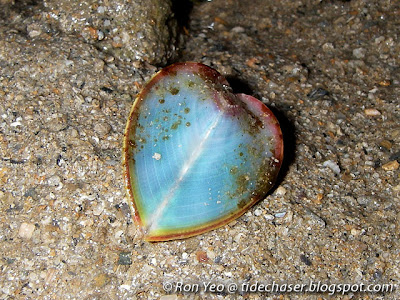
It can come in various colours, and often, the anterior and posterior sides may have different colours, ranging from pink, orange and red to green or blue. As such, this species is often collected for the shellcraft industry, and is threatened by over-collection in some areas sometimes. It can grow to about 7cm long.

Previously, the giant clams were placed under a different family, Tridacnidae, but recent genetic studies placed them in the subfamily Tridacninae instead. The above species is a Boring Giant Clam (Tridacna crocea), which can be found boring into rocks and corals, growing to about 15cm.

Like most other cockle species, all giant clams feed on plankton and tiny organic particles in the water. At the same time, they harbour symbiotic algae in their body tissue. The algae photosynthesize and pass on some of the food to the clam, in return gain shelter and protection. Some of the colors of the mantle come from the algae, while other colours may come from the colour pigments of the clam itself, believed to act as sunblock for the clam.

The Fluted Giant Clam (Tridacna squamosa) is the biggest species of bivalves in Singapore, growing to about 40cm. Like the previous species, the mantle comes in various patterns and colours, such as brown, yellow, purple, blue or green.

The common name comes from the flutes (wave-like, protruding scutes) on the shell exterior. It is believed that the flutes may help to create obstacles for predators climbing up to the opening of the shell to feed on the clam. Many giant clams are collected for food and shellcraft.
Family Veneridae
Bivalves from the family Veneridae, usually called Venus clams, have a complex tooth structure with three divergent teeth in the hinge, and a well-developed sinus at the pallial line. The shells are symmetrical, and the escutcheon and lunule are very well-developed. The ligament is external. The shapes of the various members are very variable, ranging from circular to triangular from side view, or ovate to heart-shaped when viewed from the anterior end. Some species may have obvious radial ribs or concentric ridges. As such, some species may be mistaken with members from the previous family. Many members have complicated patterns and beautiful colours. Venerid bivalves are mostly free-living, and some species may burrow. They have a folded gill structure for filtering small food particles - typical of members from this family and other related families. The foot is tongue-like. Many species are collected for food.

The Squamose Venus Clam (Anomalocardia squamosa) is found on sandy substrates. It is marked with radial ribs composed of rows of scale-like structures ("squamose" means "scaly"). The posterior end tapers to a blunt point. It may be mistaken for cockles due to the ribs, and arkshells for the somewhat squarish shape.

It has more well-developed escutcheon and lunule though (compared to cockles), and the hinge is not straight (unlike arkshells). It grows to about 3cm long.
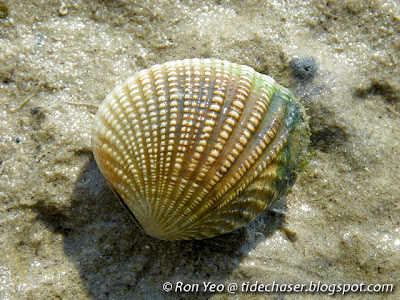
The Tumid Venus Clam (Gafrarium tumidum) is commonly found on sandy or sandy-muddy substrates, usually near rocks or other hard structures. It strong radial ribs made up of rows of small rectangular protrusions. They can be mistaken for cockles, but the latter have more protruding umbones which give them more heart-shaped shells.

Lying down on one valve, the shell appears somewhat bloated. It grows to about 3-4cm long.

The Comb Venus Clam (Gafrarium pectinatum) is very similar to the previous species with the strong radial ribs, but the shell is marked with dark brown or maroon spots.

Lying down on one valve, the shell is more compressed than and not as inflated as the previous species. It grows to about 3-4cm long.

The Forked Venus Clam (Gafrarium divaricatum) lacks the thick radial ribs, but instead is marked by many fine concentric ridges crossed by slightly diverging radial riblets, forming a continuously repeating V-shaped pattern towards the umbo.

There are usually numerous darker crooked lines on the shell exterior. It can be found on clean or muddy sand, or in sandy gravel.

The Script Venus Clam (Circe scripta) is very easily confused with the next species for their similar-looking shells. The shell surface is marked with concentric growth lines, and many may have dark brown patterns (though some can be all white). The posterior side of the shell, however, often has a portion with a somewhat straightened edge (see right side of the shell above).

Lying on one of the vales, the shell is more compressed than the next species. It gets to about 4cm long.

Circe undatina looks very similar, but appears more inflated and ovate. It also grows to about 4cm long.

Like the previous species, it has concentric growth lines as well. The patterns marking the shell exterior can be very variable though. The above has some dark brown patterns.

This one above is covered with a reddish brown stain.

Yet another Circe undatina here which is white without brown patterns.

The Rooster Venus Clam (Paphia gallus) appears shorter, with a somewhat concave edge on the anterior side. The exterior is marked with crisscrossed patterns, often with a few dark radial bands. It gets to about 6cm wide.

The Alabaster Venus Clam (Pitar alabastrum) has white shells, but often marked with stains of other colours.
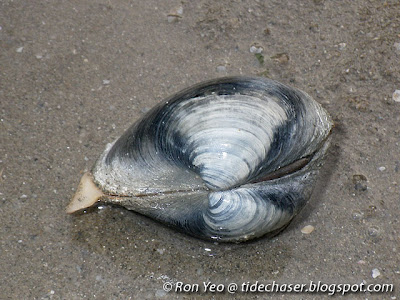
The umbones curved towards the anterior side, and the exterior surface is quite smooth though marked with concentric growth lines. It gets to about 4cm long.

The Yellow Pitar Venus Clam (Pitar citrinus) often appears yellowish when the shell is cleaned, as the common name implies. The surface is usually rather smooth, though growth lines can be seen. It gets to about 3cm long.

In the field, however, the yellowish colour may not be very obvious, and the Yellow Pitar Venus Clam can be easily confused with the previous species.

The Lettered Venus Clam (Tapes literatus) has a somewhat trapezoidal shape. The base colour of the shell is white, but the surface is often marked with black patterns.

The surface may be marked with black stains or stains of other colours. The growth lines are obvious, and the surface is generally smooth. It gets to about 8cm long.

The Flowery Venus Clam (Placamen chloroticum) has protruding, scale-like concentric ridges that are spaced wider apart compared to similar-looking Lucinid and Semelid species (see further below). There are other similar-looking Placamen spp. as well, but this species has very protruding ridges at the posterior slope, and the shape is more triangular.

The protruding scale-like ridges can be more obviously seen looking from the dorsal side.
Family Petricolidae
Bivalves from this family are often placed under the family Veneridae, though genetic studies have placed them as a separate family since the year 2010. The symmetrical shell is usually ovate, thin, and white. The hinge has two or three cardinal teeth, but there is no lateral tooth. They have a deep pallial sinus, long siphons and a narrow foot. The umbones are obviously protruding, with concentric growth lines expanding from the dorsal end to the anterior end. The animal is usually free-living, but is often found boring into clay, soft rocks or corals.

The Boring Petricola (Petricola lapicida) is a dead-coral boring bivalve, and is thus often seen half-embedded in dead corals. The prominent umbones protrude out, sometimes touching each other. The shell is white in colour, and the surface is rough, marked with concentric growth lines. Studies have shown that it can secrete chemicals to help it bore into the dead corals. The biggest I have seen s about 2cm.
Family Lucinidae
Bivalves from this family generally have rounded to subtrapezoidal shells. The umbones are small and low, while the lunule is small and often asymmetrical. The outer surface is often marked with concentric and/ or radial components. The hinge usually has two cardinal teeth, with a few lateral teeth in each valve, though some or all the teeth may be reduced or even absent. The ligament is external and somewhat sunken. In the shell interior, the anterior adductor muscle scar is narrow and elongate, often with a lobe detached from the pallial line towards the ventral side, while the posterior scar appears irregularly shaped. There is no pallial sinus. It has a long, worm-like foot. The inhalant siphon is usually replaced by a rounded anterior tube lined with mucus, separate from the exhalant siphon. Many species house symbiotic, sulphur-oxydizing chemautotrophic bacteria in their thick gills, which provide food for the clams in return for shelter.

The Corrugated Lucine Clam (Austriella corrugata) is sometimes seen in mangroves, or sandy substrates near mangroves. The shell is somewhat circular, with obvious concentric ridges.

The ligament is somewhat sunken, with an obvious posterior slope. It grows to about 5cm long.
Family Mactridae
Mactrid clams are mostly burrowers, and hence their shells are usually quite strong. The shell is symmetrical, and the surface is smooth and marked with concentric growth lines. The cardinal teeth are much reduced, and lateral teeth are usually present. The two adductor muscle scars are usually subequal, and there is a pallial line with a well-developed sinus. The siphon tubes are united and fringed at the tips. The foot is usually wedge-shaped. Most species live in shallow waters, and with their large sizes, they are extensively collected for food.

The Plain Troughshell (Mactra mera) is commonly found burrowing just under the surface of the sand. It is reddish brown in colour, and the surface is marked with fine concentric growth lines. It grows to about 7-9cm.
Family Cyrenidae
Bivalves from this family are found in fresh or brackish water, and in Singapore, the native species are found in the mangroves. The symmetrical shells are somewhat sub-triangular, with two or three cardinal teeth and several laterals. The surface is usually marked with concentric growth lines. The foot is large and strong, while the siphon is short. Cyrenid clams are free-living with no byssus. Many species are collected for food.

The Giant Mud Clam (Geloina erosa), locally known as "Lokan", can grow to more than 10cm long. It can often be found moving half buried in the mud. It is usually brown in colour, and the shell exterior is marked with coarse growth lines.

Dead shells can often be seen in mangroves as well.
Family Tellinidae
Tellinid shells usually appear compressed and translucent. The hinge has two cardinal teeth, and the ligament is external. The pallial sinus is deep, and the foot is long and extensible. The siphons are long, slender and separate. The anterior adductor muscle scar is somewhat elongated, while the posterior one is somewhat rounded or quadrate. The have a deep pallial sinus. Tellinid bivalves are mostly found just below the surface of sandy or muddy substrates. Many species are marked with beautiful colours and patterns. In some species one of the valves may be flatter than the other. Many species are collected for shellcraft.
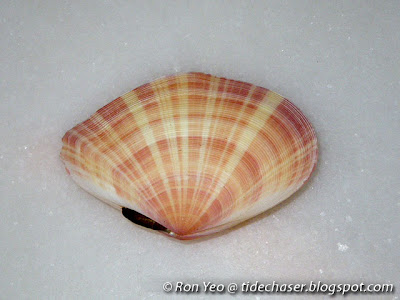
The Virgate Tellin Clam (Tellina virgata) is marked with reddish growth lines of different shades, with radiating bands of lighter tones, resulting in an interestingly patterned exterior. It gets to about 5-8cm long.

The Cross Tellin Clam (Tellina staurella) resembles the previous species, though it may appear yellowish sometimes. The shell exterior is glossy, compared to the rougher and matte surface of the previous species. The maximum shell size is about 5cm.
Family Semelidae
Semelid bivalves generally have thin shells with a wave-like fold towards the posterior end. The hinge has two cardinal teeth and lateral teeth. The hinge ligament has two parts - a short external posterior ligament and an internal ligament located between the two valves behind the umbones in a small pit of hinge plates. On the shell interior, each valve has two adductor muscle scars, and a pallial line with a deep sinus. The siphons are long and divergent.

Semele carnicolor is sometimes seen on our shores on muddy sandy substrates. The colour of the shell is whitish to pale brown, the exterior is marked with distinct, scale-like, concentric ridges. The space between the ridges is about seven to eight times the width of the scale-like ridges.

Looking from the ventral side, a wave-like fold towards the posterior end (on the left) can be seen.
Family Corbulidae
The corbulids are usually small-sized with a simple hinge formed by a recurved tooth fitting into a socket. The shells may be ovate, oblong or triangular, usually marked with concentric ridges. The posterior end usually tapers to a truncate or angular tip. The right valve is usually bigger and overlaps the left shell, and depending on the species the two valves may differ in shape and ornamentation. It has short, united siphons which are fringed. They are usually found living in sandy or muddy substrates, or attached to hard substrates.

Corbula crassa is seldom seen on our shores. It has obvious whitish concentric growth lines with a few darker ones in between. The posterior end often tapers to a pointed tip.

It is usually small, about 1cm in size, and usually found on sandy or sandy-muddy substrates.
Family Chamidae
Commonly called jewel boxes or jewel box clams, the chamid bivalves superficially resemble oysters as most species (there are exceptions) are cemented to hard substrates such as rocks or other shells. The shells are thick, with a somewhat round outline but irregularly shaped. They are usually covered with short spikes or leaf-like structures, trapping sediment and algae. They are thus often overlooked and hard to identify in the field. The ligament is external, while the hinge thick and arched with a few large curved teeth and corresponding sockets. The shell interior is porcelaneous, and each valve has two large, subequal and ovate adductor muscles scars. There is a pallial line without a sinus. Since they are stuck to hard substrates and need not move around, they have a very reduced foot. They are collected for food and the shells are sometimes used as lime material or for shellcraft. I personally find it hard to identify jewel boxes to the species level, and hence will not attempt to provide the species name for the below examples.

The above features a living Chama sp. attached to a sea wall, covered with algae and sediment, blending nicely into the surrounding. It is usually hard to identify the species in the field.

Sometimes, specimens not overgrown with encrusting organisms can be found under rocks. This specimen is covered with short, bumpy spikes, but identification is usually still hard even if they are not covered with encrusting organisms.
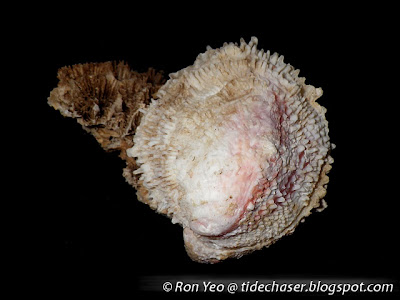
This specimen which appear somewhat similar to the previous specimen (with short spiky projections) has been properly cleaned. When alive, it attached itself to a dead coral.

A look at the interior of the shell.

Sometimes, specimens with plate-like or leaf-like projections can also be found.
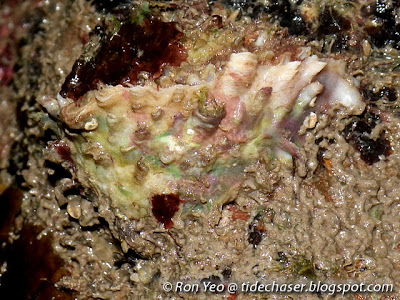
When they are not covered with encrusting organisms, the beautiful colours and patterns can be seen.

This is a cleaned specimen with elaborated leaf-like projections and pretty colours on the exterior.

Some jewel box clams may have both short spiky structures and longer leaf-like projections.
Family Galeommatidae
Bivalves from the family Galeommatidae are usually small and found under rocks or coral rubble. They have very reduced and flexible shells, mostly enclosed within the well-developed mantle. The hinge is irregular, with tiny cardinal teeth and somewhat obscure lateral teeth. Some species may behave like slugs, sliding over the substrate using their well-developed foot, while others can move in short leaps.

When out of the water, galeommatid clams appear like fleshy lumps.
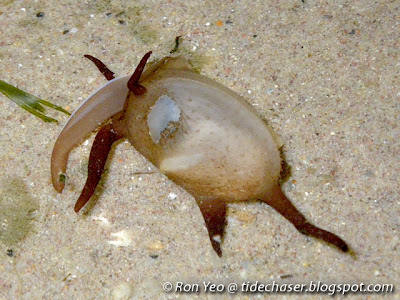
The Philippine Scintilla Clam (Scintilla philippinensis) is commonly seen under rocks at Singapore's southern islands, growing to about 1cm long. It is brownish colour, with darker tentacle-like outgrowths. It moves in short leaps with its strong foot.
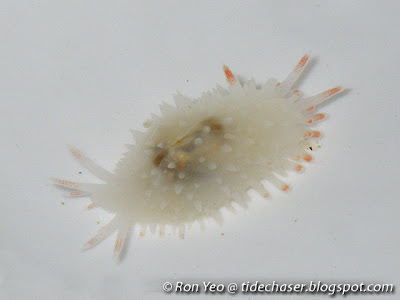
This unknown Scintilla sp. has some of its papillae with orange tips, and moves like a slug.

This galeommatid clam lacks the longer tentacle-like structures, and moves by using its powerful foot.
Family Solenidae
Bivalves from this family typically have elongated shells, appearing somewhat rectangular in shape. The two valves cannot close completely, leaving an opening at both the anterior and posterior ends. The hinge ligament is external, while the hinge has two or three small teeth. The umbones are not obvious, and the exterior of the shell is usually marked with concentric growth lines. The edges of the valves are very sharp, and hence they are often called razor clams. They have a very strong, cylindrical foot, which allows them to burrow quickly into the sand vertically. The anterior adductor muscle scar is usually larger than the posterior one. The pallial sinus is relatively shallow. The siphons can be short or long, and are fused, at least at the base. They are often collected for food.

The Grooved Razor Clam (Solen vagina) grows to about 10cm long, and is usually marked with purplish concentric growth lines.

Here is an unknown Solen sp.
Family Clavagellidae
Bivalves from the family Clavagellidae have an interesting life cycle. They begin their life like other bivalves with two separate valves, but as they mature, they will burrow into the sandy or muddy substrates and build a tube. The valves will be reduced to a pair of round structures stuck to one side of the tube surface.

The anterior end of the tube faces downwards, with a cap-like structure marked with numerous tiny holes, resembling the sieve of a water pot, and hence the common name "watering pot shell".

The posterior end will stick out of the substrate, with an opening which allows the animal to filter feed.
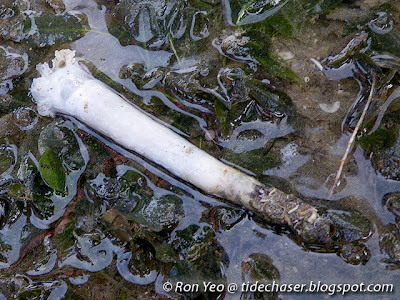
The Common Watering Pot (Verpa penis) is sometimes seen half-buried in sandy substrates, often mistaken for tube worms. The part of the tube which is covered with encrusting organisms in the above photo is the part that is not buried but exposed above the surface of the substrate.
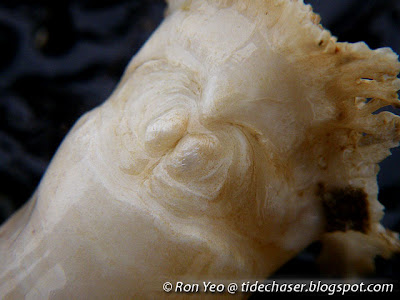
The reduced valves can still be seen on the side of the tube, located quite close to the anterior end, and with the area just beside the valves marked with obvious concentric ridges. The entire tube can grow to about 15cm long.
Family Teredinidae
The Teredinid bivalves, more commonly called shipworms, are wood-boring, marine bivalves that exist with nitrogen-fixing bacteria which provide them with enzymes to digest the wood they have consumed. Due to the burrows they create as they feed, they cause damage to wooden structures, such as jetties, ships and pillars of bridges. Shipworms begin their life as free-swimming juveniles with eyes for a brief period, which eventually disappear after they settle on submerged wood, which they will bore into using the foot and possibly also by scraping with the valves, creating tunnels in the wood in the process. The animals themselves appear worm-like, and most line all or part of their burrows with a layer of calcareous tube. When the wood gets eroded away, the tubes get exposed and may be mistaken for tube worms or worm snails.

The above shows some unidentified shipworms, which was exposed when the dead wood was eroded away.
References
Here are some of the heterodonts that I have photographed and identified on our shores so far (thanks to Siong Kiat who gave tips on how to identify them!). You may want to take a look at the diagram below if you are not familiar with the names of the parts, so as to better understand the terms used.

Family Cardiidae
Traditionally, the family Cardiidae consists of only the true cockles, but recent studies shown that the giant clams (previously placed in a family of their own, Tridacnidae) should be part of this family as well. Members of this family typically have strong, compact and completely symmetrical shells which appear heart-shaped when viewed from the anterior end due to the prominent umbones. The shell usually has obvious radial ribs, and on the inside, there are two cardinal teeth in each valve and no pallial sinus. They have short siphons, external ligaments, and most of the motile species have a well-developed, sickle-shaped foot, which allows them to move in short leaps over the substrate. Many species harbour symbiotic algae, which photosynthesize and share the food produced with the host bivalves, in exchange for shelter and nutrients (the metabolic waste of the host). Some species are collected for food or for making shellcraft. Note that the "See Hum" or "blood cockles" used in various local dishes are not true cockles, but arkshells (Family Arcidae) instead.
Here are some of the cockles that I have photographed:

The Pacific Yellow Cockle (Vasticardium flavum) is usually found among seagrass or seaweed. It is usually somewhat yellowish in colour, and often with dark stains.

Like other cockles, the shell appears heart-shaped when viewed from the front or back. The radial ribs are marked with scale-like structures running down the length. It gets to about 5cm long.

This is possibly a Laevicardium sp., which has more pointed umbones and a more elongated shell. It is usually seen on sandy substrates among seagrass or seaweed.

Another view of the same shell, which exhibits the heart-shaped appearance. It is about 5cm long.

The Strawberry Cockle (Fragum unedo) is seen on sandy substrate on reef flats. The shell, which appears somewhat squarish, is marked with red spots.

Here's another view of the shell. Strawberry cockles can grow to about 5cm long.

The Heart Cockle (Corculum cardissa), unlike most other cockles, are compressed anterior-posteriorly (front-back), and appears like a flattened heart, with the opening in the middle of the heart. The shell is rather thin, so as to allow the symbiotic algae better access to sunlight for photosynthesis.

It can come in various colours, and often, the anterior and posterior sides may have different colours, ranging from pink, orange and red to green or blue. As such, this species is often collected for the shellcraft industry, and is threatened by over-collection in some areas sometimes. It can grow to about 7cm long.

Previously, the giant clams were placed under a different family, Tridacnidae, but recent genetic studies placed them in the subfamily Tridacninae instead. The above species is a Boring Giant Clam (Tridacna crocea), which can be found boring into rocks and corals, growing to about 15cm.

Like most other cockle species, all giant clams feed on plankton and tiny organic particles in the water. At the same time, they harbour symbiotic algae in their body tissue. The algae photosynthesize and pass on some of the food to the clam, in return gain shelter and protection. Some of the colors of the mantle come from the algae, while other colours may come from the colour pigments of the clam itself, believed to act as sunblock for the clam.

The Fluted Giant Clam (Tridacna squamosa) is the biggest species of bivalves in Singapore, growing to about 40cm. Like the previous species, the mantle comes in various patterns and colours, such as brown, yellow, purple, blue or green.

The common name comes from the flutes (wave-like, protruding scutes) on the shell exterior. It is believed that the flutes may help to create obstacles for predators climbing up to the opening of the shell to feed on the clam. Many giant clams are collected for food and shellcraft.
Family Veneridae
Bivalves from the family Veneridae, usually called Venus clams, have a complex tooth structure with three divergent teeth in the hinge, and a well-developed sinus at the pallial line. The shells are symmetrical, and the escutcheon and lunule are very well-developed. The ligament is external. The shapes of the various members are very variable, ranging from circular to triangular from side view, or ovate to heart-shaped when viewed from the anterior end. Some species may have obvious radial ribs or concentric ridges. As such, some species may be mistaken with members from the previous family. Many members have complicated patterns and beautiful colours. Venerid bivalves are mostly free-living, and some species may burrow. They have a folded gill structure for filtering small food particles - typical of members from this family and other related families. The foot is tongue-like. Many species are collected for food.

The Squamose Venus Clam (Anomalocardia squamosa) is found on sandy substrates. It is marked with radial ribs composed of rows of scale-like structures ("squamose" means "scaly"). The posterior end tapers to a blunt point. It may be mistaken for cockles due to the ribs, and arkshells for the somewhat squarish shape.

It has more well-developed escutcheon and lunule though (compared to cockles), and the hinge is not straight (unlike arkshells). It grows to about 3cm long.

The Tumid Venus Clam (Gafrarium tumidum) is commonly found on sandy or sandy-muddy substrates, usually near rocks or other hard structures. It strong radial ribs made up of rows of small rectangular protrusions. They can be mistaken for cockles, but the latter have more protruding umbones which give them more heart-shaped shells.

Lying down on one valve, the shell appears somewhat bloated. It grows to about 3-4cm long.

The Comb Venus Clam (Gafrarium pectinatum) is very similar to the previous species with the strong radial ribs, but the shell is marked with dark brown or maroon spots.

Lying down on one valve, the shell is more compressed than and not as inflated as the previous species. It grows to about 3-4cm long.

The Forked Venus Clam (Gafrarium divaricatum) lacks the thick radial ribs, but instead is marked by many fine concentric ridges crossed by slightly diverging radial riblets, forming a continuously repeating V-shaped pattern towards the umbo.

There are usually numerous darker crooked lines on the shell exterior. It can be found on clean or muddy sand, or in sandy gravel.

The Script Venus Clam (Circe scripta) is very easily confused with the next species for their similar-looking shells. The shell surface is marked with concentric growth lines, and many may have dark brown patterns (though some can be all white). The posterior side of the shell, however, often has a portion with a somewhat straightened edge (see right side of the shell above).

Lying on one of the vales, the shell is more compressed than the next species. It gets to about 4cm long.

Circe undatina looks very similar, but appears more inflated and ovate. It also grows to about 4cm long.

Like the previous species, it has concentric growth lines as well. The patterns marking the shell exterior can be very variable though. The above has some dark brown patterns.

This one above is covered with a reddish brown stain.

Yet another Circe undatina here which is white without brown patterns.

The Rooster Venus Clam (Paphia gallus) appears shorter, with a somewhat concave edge on the anterior side. The exterior is marked with crisscrossed patterns, often with a few dark radial bands. It gets to about 6cm wide.

The Alabaster Venus Clam (Pitar alabastrum) has white shells, but often marked with stains of other colours.

The umbones curved towards the anterior side, and the exterior surface is quite smooth though marked with concentric growth lines. It gets to about 4cm long.

The Yellow Pitar Venus Clam (Pitar citrinus) often appears yellowish when the shell is cleaned, as the common name implies. The surface is usually rather smooth, though growth lines can be seen. It gets to about 3cm long.

In the field, however, the yellowish colour may not be very obvious, and the Yellow Pitar Venus Clam can be easily confused with the previous species.

The Lettered Venus Clam (Tapes literatus) has a somewhat trapezoidal shape. The base colour of the shell is white, but the surface is often marked with black patterns.

The surface may be marked with black stains or stains of other colours. The growth lines are obvious, and the surface is generally smooth. It gets to about 8cm long.

The Flowery Venus Clam (Placamen chloroticum) has protruding, scale-like concentric ridges that are spaced wider apart compared to similar-looking Lucinid and Semelid species (see further below). There are other similar-looking Placamen spp. as well, but this species has very protruding ridges at the posterior slope, and the shape is more triangular.

The protruding scale-like ridges can be more obviously seen looking from the dorsal side.
Family Petricolidae
Bivalves from this family are often placed under the family Veneridae, though genetic studies have placed them as a separate family since the year 2010. The symmetrical shell is usually ovate, thin, and white. The hinge has two or three cardinal teeth, but there is no lateral tooth. They have a deep pallial sinus, long siphons and a narrow foot. The umbones are obviously protruding, with concentric growth lines expanding from the dorsal end to the anterior end. The animal is usually free-living, but is often found boring into clay, soft rocks or corals.

The Boring Petricola (Petricola lapicida) is a dead-coral boring bivalve, and is thus often seen half-embedded in dead corals. The prominent umbones protrude out, sometimes touching each other. The shell is white in colour, and the surface is rough, marked with concentric growth lines. Studies have shown that it can secrete chemicals to help it bore into the dead corals. The biggest I have seen s about 2cm.
Family Lucinidae
Bivalves from this family generally have rounded to subtrapezoidal shells. The umbones are small and low, while the lunule is small and often asymmetrical. The outer surface is often marked with concentric and/ or radial components. The hinge usually has two cardinal teeth, with a few lateral teeth in each valve, though some or all the teeth may be reduced or even absent. The ligament is external and somewhat sunken. In the shell interior, the anterior adductor muscle scar is narrow and elongate, often with a lobe detached from the pallial line towards the ventral side, while the posterior scar appears irregularly shaped. There is no pallial sinus. It has a long, worm-like foot. The inhalant siphon is usually replaced by a rounded anterior tube lined with mucus, separate from the exhalant siphon. Many species house symbiotic, sulphur-oxydizing chemautotrophic bacteria in their thick gills, which provide food for the clams in return for shelter.

The Corrugated Lucine Clam (Austriella corrugata) is sometimes seen in mangroves, or sandy substrates near mangroves. The shell is somewhat circular, with obvious concentric ridges.

The ligament is somewhat sunken, with an obvious posterior slope. It grows to about 5cm long.
Family Mactridae
Mactrid clams are mostly burrowers, and hence their shells are usually quite strong. The shell is symmetrical, and the surface is smooth and marked with concentric growth lines. The cardinal teeth are much reduced, and lateral teeth are usually present. The two adductor muscle scars are usually subequal, and there is a pallial line with a well-developed sinus. The siphon tubes are united and fringed at the tips. The foot is usually wedge-shaped. Most species live in shallow waters, and with their large sizes, they are extensively collected for food.

The Plain Troughshell (Mactra mera) is commonly found burrowing just under the surface of the sand. It is reddish brown in colour, and the surface is marked with fine concentric growth lines. It grows to about 7-9cm.
Family Cyrenidae
Bivalves from this family are found in fresh or brackish water, and in Singapore, the native species are found in the mangroves. The symmetrical shells are somewhat sub-triangular, with two or three cardinal teeth and several laterals. The surface is usually marked with concentric growth lines. The foot is large and strong, while the siphon is short. Cyrenid clams are free-living with no byssus. Many species are collected for food.

The Giant Mud Clam (Geloina erosa), locally known as "Lokan", can grow to more than 10cm long. It can often be found moving half buried in the mud. It is usually brown in colour, and the shell exterior is marked with coarse growth lines.

Dead shells can often be seen in mangroves as well.
Family Tellinidae
Tellinid shells usually appear compressed and translucent. The hinge has two cardinal teeth, and the ligament is external. The pallial sinus is deep, and the foot is long and extensible. The siphons are long, slender and separate. The anterior adductor muscle scar is somewhat elongated, while the posterior one is somewhat rounded or quadrate. The have a deep pallial sinus. Tellinid bivalves are mostly found just below the surface of sandy or muddy substrates. Many species are marked with beautiful colours and patterns. In some species one of the valves may be flatter than the other. Many species are collected for shellcraft.

The Virgate Tellin Clam (Tellina virgata) is marked with reddish growth lines of different shades, with radiating bands of lighter tones, resulting in an interestingly patterned exterior. It gets to about 5-8cm long.

The Cross Tellin Clam (Tellina staurella) resembles the previous species, though it may appear yellowish sometimes. The shell exterior is glossy, compared to the rougher and matte surface of the previous species. The maximum shell size is about 5cm.
Family Semelidae
Semelid bivalves generally have thin shells with a wave-like fold towards the posterior end. The hinge has two cardinal teeth and lateral teeth. The hinge ligament has two parts - a short external posterior ligament and an internal ligament located between the two valves behind the umbones in a small pit of hinge plates. On the shell interior, each valve has two adductor muscle scars, and a pallial line with a deep sinus. The siphons are long and divergent.

Semele carnicolor is sometimes seen on our shores on muddy sandy substrates. The colour of the shell is whitish to pale brown, the exterior is marked with distinct, scale-like, concentric ridges. The space between the ridges is about seven to eight times the width of the scale-like ridges.

Looking from the ventral side, a wave-like fold towards the posterior end (on the left) can be seen.
Family Corbulidae
The corbulids are usually small-sized with a simple hinge formed by a recurved tooth fitting into a socket. The shells may be ovate, oblong or triangular, usually marked with concentric ridges. The posterior end usually tapers to a truncate or angular tip. The right valve is usually bigger and overlaps the left shell, and depending on the species the two valves may differ in shape and ornamentation. It has short, united siphons which are fringed. They are usually found living in sandy or muddy substrates, or attached to hard substrates.

Corbula crassa is seldom seen on our shores. It has obvious whitish concentric growth lines with a few darker ones in between. The posterior end often tapers to a pointed tip.

It is usually small, about 1cm in size, and usually found on sandy or sandy-muddy substrates.
Family Chamidae
Commonly called jewel boxes or jewel box clams, the chamid bivalves superficially resemble oysters as most species (there are exceptions) are cemented to hard substrates such as rocks or other shells. The shells are thick, with a somewhat round outline but irregularly shaped. They are usually covered with short spikes or leaf-like structures, trapping sediment and algae. They are thus often overlooked and hard to identify in the field. The ligament is external, while the hinge thick and arched with a few large curved teeth and corresponding sockets. The shell interior is porcelaneous, and each valve has two large, subequal and ovate adductor muscles scars. There is a pallial line without a sinus. Since they are stuck to hard substrates and need not move around, they have a very reduced foot. They are collected for food and the shells are sometimes used as lime material or for shellcraft. I personally find it hard to identify jewel boxes to the species level, and hence will not attempt to provide the species name for the below examples.

The above features a living Chama sp. attached to a sea wall, covered with algae and sediment, blending nicely into the surrounding. It is usually hard to identify the species in the field.

Sometimes, specimens not overgrown with encrusting organisms can be found under rocks. This specimen is covered with short, bumpy spikes, but identification is usually still hard even if they are not covered with encrusting organisms.

This specimen which appear somewhat similar to the previous specimen (with short spiky projections) has been properly cleaned. When alive, it attached itself to a dead coral.

A look at the interior of the shell.

Sometimes, specimens with plate-like or leaf-like projections can also be found.

When they are not covered with encrusting organisms, the beautiful colours and patterns can be seen.

This is a cleaned specimen with elaborated leaf-like projections and pretty colours on the exterior.

Some jewel box clams may have both short spiky structures and longer leaf-like projections.
Family Galeommatidae
Bivalves from the family Galeommatidae are usually small and found under rocks or coral rubble. They have very reduced and flexible shells, mostly enclosed within the well-developed mantle. The hinge is irregular, with tiny cardinal teeth and somewhat obscure lateral teeth. Some species may behave like slugs, sliding over the substrate using their well-developed foot, while others can move in short leaps.

When out of the water, galeommatid clams appear like fleshy lumps.

The Philippine Scintilla Clam (Scintilla philippinensis) is commonly seen under rocks at Singapore's southern islands, growing to about 1cm long. It is brownish colour, with darker tentacle-like outgrowths. It moves in short leaps with its strong foot.

This unknown Scintilla sp. has some of its papillae with orange tips, and moves like a slug.

This galeommatid clam lacks the longer tentacle-like structures, and moves by using its powerful foot.
Family Solenidae
Bivalves from this family typically have elongated shells, appearing somewhat rectangular in shape. The two valves cannot close completely, leaving an opening at both the anterior and posterior ends. The hinge ligament is external, while the hinge has two or three small teeth. The umbones are not obvious, and the exterior of the shell is usually marked with concentric growth lines. The edges of the valves are very sharp, and hence they are often called razor clams. They have a very strong, cylindrical foot, which allows them to burrow quickly into the sand vertically. The anterior adductor muscle scar is usually larger than the posterior one. The pallial sinus is relatively shallow. The siphons can be short or long, and are fused, at least at the base. They are often collected for food.

The Grooved Razor Clam (Solen vagina) grows to about 10cm long, and is usually marked with purplish concentric growth lines.

Here is an unknown Solen sp.
Family Clavagellidae
Bivalves from the family Clavagellidae have an interesting life cycle. They begin their life like other bivalves with two separate valves, but as they mature, they will burrow into the sandy or muddy substrates and build a tube. The valves will be reduced to a pair of round structures stuck to one side of the tube surface.

The anterior end of the tube faces downwards, with a cap-like structure marked with numerous tiny holes, resembling the sieve of a water pot, and hence the common name "watering pot shell".

The posterior end will stick out of the substrate, with an opening which allows the animal to filter feed.

The Common Watering Pot (Verpa penis) is sometimes seen half-buried in sandy substrates, often mistaken for tube worms. The part of the tube which is covered with encrusting organisms in the above photo is the part that is not buried but exposed above the surface of the substrate.

The reduced valves can still be seen on the side of the tube, located quite close to the anterior end, and with the area just beside the valves marked with obvious concentric ridges. The entire tube can grow to about 15cm long.
Family Teredinidae
The Teredinid bivalves, more commonly called shipworms, are wood-boring, marine bivalves that exist with nitrogen-fixing bacteria which provide them with enzymes to digest the wood they have consumed. Due to the burrows they create as they feed, they cause damage to wooden structures, such as jetties, ships and pillars of bridges. Shipworms begin their life as free-swimming juveniles with eyes for a brief period, which eventually disappear after they settle on submerged wood, which they will bore into using the foot and possibly also by scraping with the valves, creating tunnels in the wood in the process. The animals themselves appear worm-like, and most line all or part of their burrows with a layer of calcareous tube. When the wood gets eroded away, the tubes get exposed and may be mistaken for tube worms or worm snails.

The above shows some unidentified shipworms, which was exposed when the dead wood was eroded away.
References
- Abbott, R. T., 1991. Seashells of Southeast Asia. Graham Brash, Singapore. 145 pp.
- Anderson, L.C., and P. D. Roopnarine. 2003. Evolution and phylogenetic relationships among Neogene Corbulidae (Bivalvia; Myoidea) of tropical America. Journal of Paleontology, 77: 890-906.
- Bowling, B. 2012. Identification Guide to Marine Organisms of Texas. Retrieved Nov 25, 2012, from http://txmarspecies.tamug.edu.
- Bunje, P. 2001. The bivalvia. University of California Museum of Paleontology. Retrieved Nov 14, 2012, from http://www.ucmp.berkeley.edu/taxa/inverts/mollusca/bivalvia.php.
- Canapa et al. 2001. A molecular phylogeny of Heterodonta (Bivalvia) based on small ribosomal subunit RNA sequences. Molecular Phylogenetics and Evolution, Vol. 21, No. 1, October, pp. 156–161.
- Carpenter, K. E. & V. H. Niem (eds), 1998-2001. FAO species identification guide for fishery purposes. The living marine resources of the Western Central Pacific. Volumes 1 to 6. FAO, Rome. pp. 1-4218.
- Carter, J. G. et al. 2011. A synoptical classification of the bivalvia (mollusca). Paleontological Contributions 4: 1‑47.
- Cox, L. R., N. D. Newell et al. 1969. Treatise on Invertebrate Paleontology: Part N. Mollusca 6. Bivalvia, Volume 2. The Geological Society of America, Inc. and The University of Kansas.
- Distel D.L., W. Morrill, N. MacLaren-Toussaint, D. Franks & J. Waterbury. 2003. Teredinibacter turnerae gen. nov., sp. nov., a dinitrogen-fixing, cellulolytic, endosymbiotic gamma-proteobacterium isolated from the gills of wood-boring molluscs (Bivalvia: Teredinidae). International Journal of Systematic and Evolutionary Microbiology 52 (6): 2261–2269.
- Gladys Archerd Shell Collection at Washington State University Tri-Cities Natural History Museum. 2008. Retrieved September 26, 2012, from http://shells.tricity.wsu.edu/ArcherdShellCollection/ShellCollection.html.
- Oliver, A. P. H., 2012. Philip's guide to seashells of the world. Philip's, London. 320 pp.
- Rogers, J. E., 1908. The Shell Book - A Popular Guide to a Knowledge of the Families of Living Molluscs, and an Aid to the identification of Shells Native and Foreign. Charles T. Branford Co., Publishers. Boston, Massachusetts. 485 pp.
- Simone, L. R. L. & C. H. Guimarães. 2008. Comparative anatomical study of two species of Semele from Thailand (Bivalvia: Tellinoidea). The Raffles Bulletin of Zoology, Supplement 18: 137–149.
- Sipe, A. R., A. E. Wilbur and S. C. Cary. 2000. Bacterial symbiont transmission in the wood-boring shipworm Bankia setacea (Bivalvia: Teredinidae). App. and Env. Microbiol. 66 (4): 1685-1691.
- Tan, K. S. & L. M. Chou, 2000. A guide to common seashells of Singapore. Singapore Science Centre, Singapore. 168 pp.
- Tan, S. K. & H. P. M. Woo, 2010. A preliminary checklist of the molluscs of Singapore. Raffles Museum of Biodiversity Research, National University of Singapore, Singapore. 78 pp. Uploaded 02 June 2010.
- Tan, S. K. & R. K. H. Yeo, 2010. The intertidal molluscs of Pulau Semakau: preliminary results of “Project Semakau". Nature in Singapore, 3: 287–296.
- Tan, S. K., S. H. Tan & M. E. Y. Low, 2011. A reassessment of Verpa penis (Linnaeus, 1758) (Mollusca: Bivalvia: Clavagelloidea), a species presumed nationally extinct. Nature in Singapore 2011, 4: 5–8.
- Wong, H. W., 2009. The Mactridae of East Coast Park, Singapore. Nature in Singapore, 2: 283–296.
- World Register of Marine Species. 2012. Retrieved Nov 14, 2012, from http://www.marinespecies.org.

No comments:
Post a Comment